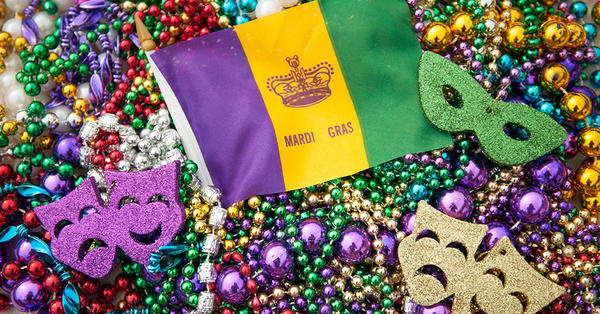March 1 marks Mardi Gras, or Fat Tuesday, traditionally the last day of indulgence before the austerities of Lent begin on Ash Wednesday. Forty days of fasting follow until Easter Sunday, in the traditional Catholic calendar followed for centuries by a great deal of Europe and its eventual colonial holdings throughout the world. The Mardi Gras celebration in New Orleans is world famous, and an iconic symbol of the Southern United States: the colorful floats tended to lovingly by “krewes” throughout the year, volunteer organizations that lovingly keep up the parade’s tradition; the city’s distinctive jazz music; a reputation for debauchery and raucous celebration. However, Mardi Gras is also celebrated in other southern cities like Mobile, Alabama and Athens, Georgia.
In many ways, Mardi Gras has always represented to me the South I missed out on by being a Virginian. The area surrounding my state is known as the DelMarVa area: an acronym for Delaware, Maryland, and Virginia. All three states are known for a certain nondescript atmosphere, quaint and quiet places with a more subtle, mellow variant of “southern hospitality.” The film and television images of New Orleans and its Mardi Gras were a view into another world: the convivial keen of jazz saxophones, the mystery of shaded eyes leering out of colorful Carnival masks, the lights and colors of parade floats guided down the Quarter’s compact streets by Krewe members in feathered costumes, all of this shrouded in legends of the city’s folkloric vampires and voodoo queens. My state, with its prim British Federalist brick houses, had no answer for the drama and decadence of New Orleans, of the multicultural roots and the unique rhythm of this iconic Southern celebration.
Mardi Gras is where you find it. As world famous as the New Orleans celebration has long been, the holiday itself is becoming steadily more popular across the region. It/s the time of year I’m starting to spy cheap sequin and diamante Carnvial masks and boxes of Polish doughnuts, a staple Mardi Gras treat, for sale even in my state, on the northern scale of the American South. If you’re looking for Fat Tuesday vibes this March 1, try:
King Cake: King Cake is the crown jewel of private Mardi Gras parties. A sticky sweet brioche cake dyed in the day’s signature colors of green, gold, and purple. The cake, like the day, is rooted in old world religious associations. It’s a variant of a dessert served traditionally throughout Western Europe from Epiphany (January 6, the last day of Christmastide) up to Fat Tuesday. A toy baby symbolizing the Christ, or a bean or cooked pea, is hidden in one slice of the cake, and tradition holds that the person who bites into it is either King or Queen for the day, or tasked with serving the King Cake at next year’s Mardi Gras gathering.
“Iko Iko” or “Jockamo”: “Iko Iko”, or “Jockamo” is a song shrouded in mystery, that has passed through many hands. The lyrics are a linguistic mystery in themselves, but the refrain “Iko! Iko! Iko, iko, a-nay! Jockamo feena na na nay…” has become synonymous with the party hard Mardi Gras spirit. First written and recorded by James Crawford as “Jockamo” in 1953, the group the Dixie Cups later had far more success with their version, “Iko Iko”, in 1965. The song tells of either a skirmish between tribes of Indigenous Americans in Louisiana’s pre-Colonial past, or a feud between Mardi Gras krewes, and has been covered by many artists, including iconic New Orleans rock band Cowboy Mouth.
The Lives of the Mayfair Witches Series by Anne Rice: In the early 1990s, the late novelist Anne Rice came home, to her native New Orleans, after spending many decades in Northern California. Her 1970s novel Interview With the Vampire, perhaps more than any other literary work, has shaped how the world sees New Orleans and how the city sees itself. However, beginning with 1990s’ The Witching Hour, Rice began to tell a mythology of ambition and witchcraft that encompassed even more of the city’s history and culture than her previous work. Mardi Gras, of course, is a thread that winds through the novels, as Rice lovingly renders to the page traditions and reminiscences only a native would know, and grounds a major event of the series on a fateful Fat Tuesday.
Treme: Perhaps no other Southern city is as romanticized as New Orleans. In fiction and film, its horrors and charms are often supernatural, like the mythos of Rice’s vampires and witches. However, the HBO series which aired from 2010-13 takes a more realistic perspective, looking at how the city’s notorious inequities in race, class, and wealth played into the recovery of the predominantly African-American Treme neighborhood in the wake of 2005’s Hurricane Katrina. Jazz Music and Mardi Gras play their part in this celebration of the city’s pride and the human spirit. “Treme” is available to be streamed on HBO Max.
More From LWOS Life
Make sure to stay tuned to LWOS Life for more on this and other stories from around the world of entertainment, culture and more, as they develop. You can always count on LWOS Life to be on top of the major news in the world of entertainment; whilst also providing you with editorials on everything from beer to movie reviews.

